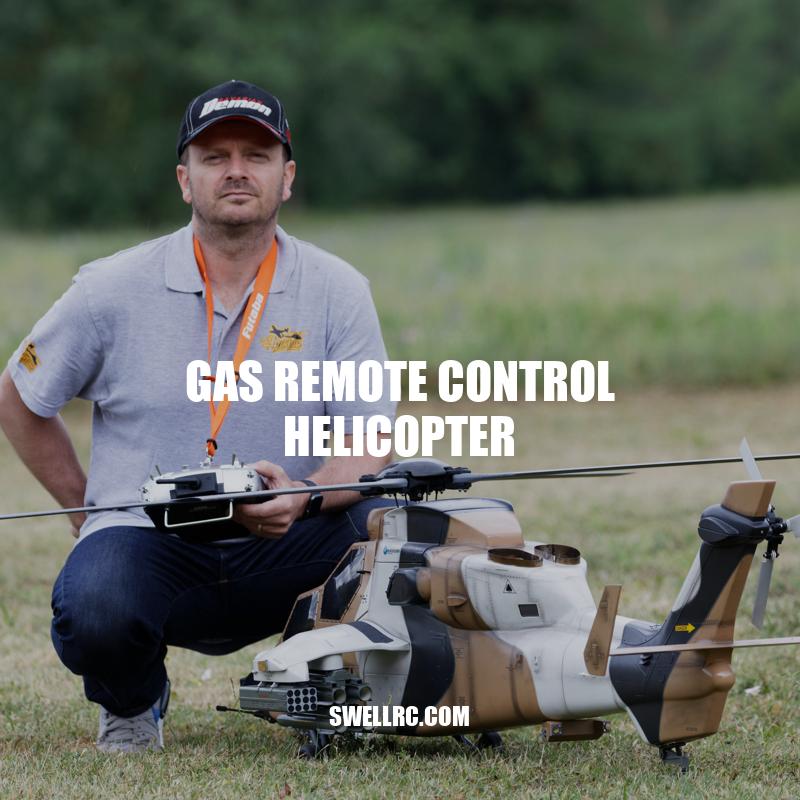Gas Remote Control Helicopters: Advantages, Workings, and Safety
Gas remote control helicopters have become increasingly popular among aerial hobbyists and enthusiasts in recent years. These helicopters are powered by gasoline engines that offer longer flight times, higher power output, and greater maneuverability than battery-operated models. A gas remote control helicopter provides a more realistic flying experience and is perfect for entertainment, aerial photography, or videography. These models are designed for skilled pilots who are looking for a more intricate and challenging experience when flying remote control helicopters. The technical aspects of gas-powered models differ from electric ones, and understanding how they work helps pilots get the best performance from their helicopters. In this article, we will explore the different types of gas remote control helicopters, the benefits and drawbacks of using them, their maintenance requirements, and other important considerations.
How Gas Remote Control Helicopters Work
Gas-powered remote control helicopters are typically powered by engines such as two-stroke or four-stroke gasoline engines. These engines require a mixture of gasoline and oil to function correctly. Gas helicopters work by igniting fuel through spark plugs, which makes them much faster than typical battery-powered helicopters, which rely on electric motors. Some other technical differences between gas and electric helicopters include its flight capabilities and the strength needed to power it up.
There are a few key differences between gas and electric helicopters such as:
- Gas helicopters’ engine running time can extend the flight time to up to 45 minutes, while battery-operated ones run out of charge in around 15 minutes on average.
- Gas-powered helicopters are also capable of carrying heavier payloads, such as better cameras for aerial photography and video making or additional fuel tanks for longer flights.
- Gas helicopters are limited to flying outdoors, while battery-operated models can be flown indoors or outdoors.
For those who are interested in purchasing a gas-powered RC helicopter, there are a few popular models to consider such as SAB Goblin or Align Trex helicopters. It’s crucial to research, read product reviews, and compare models before purchasing a gas-powered helicopter. A few good resources to learn more about gas helicopters include online forums such as RCHelicopter, RC Universe, and HeliFreak.
What is the difference between gas and Nitro RC helicopters?
Here are the key differences between gas and Nitro RC helicopters:
- Gas-powered RC helicopters use gasoline as fuel, while Nitro RC helicopters use a nitro-methane and oil mixture as fuel.
- Gas RC helicopters are usually more costly but offer longer flight times and more power.
- Nitro RC helicopters tend to be cheaper and easier to operate but may provide slightly shorter flight times and less power.
When choosing between gas and Nitro RC helicopters, it ultimately comes down to personal preference and the intended use of the model. It is recommended to consult with an expert or reputable website such as RC Planet for more information on the differences and the best models for your needs.
Advantages of Gas Remote Control Helicopters
Gas-powered remote control helicopters have several advantages over their electric counterparts, including:
- Realistic Flight Behaviour: Gas helicopters have more realistic flight behaviour as compared to electric ones, making them very attractive to hobbyists.
- Customization: Pilots can customise each aspect of the helicopter such as engines, fuel systems, and blades to meet their specific preferences.
- High Power Output: Gas helicopters come with higher power output capabilities, allowing them to achieve faster speeds and improve manoeuvrability.
- Longer Flight Times: Gas-powered helicopters tend to have longer flight times and can stay in the air for up to 45 minutes depending upon the size of the fuel tank installed.
- Heavy Payload Capability: Gas helicopters can lift and carry heavier payloads such as cameras for aerial filming, making them a perfect option for cinematography.
Gas-powered helicopters are also frequently used for inspection purposes, search and rescue missions, and other industrial applications. They can be flown in a variety of weather conditions, and the gas-powered engine helps to warm them up faster in colder temperatures, increasing their reliability.
A suitable beginner gas-powered helicopter to try would be the Blade Fusion 360 which features great performance, safety features, and affordability. Here is a breakdown of some of its features:
| Feature | Description |
|---|---|
| Power System | It is powered by a 380-size brushless motor and a 30A ESC providing an efficient system that delivers great power while keeping its weight down. |
| Flight times | It has low fuel consumption but offers a longer flight time of over 10 minutes. |
| Ceaseless Rotors | It has durable and lightweight 315mm ceaseless rotors that make it quieter during flights. |
What are the advantages of helicopter transportation?
- Helicopters can fly over any obstacle or terrain, providing access to hard-to-reach areas such as mountain tops, remote islands, or disaster zones.
- Helicopters are faster than ground transportation and can cover long distances quickly. For example, a helicopter can make the trip from Manhattan to JFK airport in just six minutes.
- Helicopters offer flexibility and convenience. They can land almost anywhere, including private helipads, hotels, and even backyards, making travel arrangements more customizable to your needs.
- Helicopters provide stunning aerial views of the landscape, offering a unique and memorable experience.
If you’re interested in helicopter tours or transportation, check out websites like Blue Hawaiian Helicopters or Blade for options and booking information.
Maintenance and Safety Considerations
Gas-powered remote control helicopters require regular maintenance to ensure their proper functioning and longevity. Some of the maintenance considerations include:
- Checking the fuel system, fuel lines, carburetor, sensors and fuel tanks for any signs of leakage and clogs.
- Cleaning the helicopter to remove any dirt or debris after every flight, ensuring all moving parts are functioning smoothly and free from debris.
- Inspecting the rotor blades before every flight to check for any bends, breaks or cracks.
- Performing routine engine checks to ensure the engine is running efficiently and safely.
- Replacing parts as required to maintain the helicopter’s proper functioning.
Safety is also a key consideration when operating gas-powered helicopters. Pilots should take the following precautions:
- Operate the helicopter in a safe and controlled environment with minimal distractions or live wires present.
- Ensure the helicopter is in good condition before every flight.
- Handle fuel and fuel systems with extreme caution, as fuel vapour is highly flammable.
- Wear proper protective gear like gloves and goggles when handling the helicopter and fuel.
- Follow all Federal Aviation Administration (FAA) rules and regulations on flying remote control helicopters, such as staying under 400 feet and not flying near airports.
Pilot-warehouse.com is a great website where you can find a variety of gas remote control helicopters for purchase. They offer a range of brands including Align, Blade, Goblin and SAB. You can also find parts and accessories essential for the maintenance of the helicopter. Remember to always read the manufacturer’s instructions carefully and seek professional advice when needed.
How often do helicopters need maintenance?
Here are some general guidelines for helicopter maintenance:
- Daily inspections are required before every flight.
- Minor maintenance is typically performed every 25-50 hours of operation.
- Major maintenance is performed every 300-600 hours of operation.
- Overhaul and refurbishment may be required after several thousand hours of operation depending on the make and model of the helicopter.
For specific maintenance schedules, it’s best to consult the helicopter’s manufacturer or a certified mechanic.
Cost and Availability of Gas Remote Control Helicopters
The cost of gas remote control helicopters can vary depending on the brand, model, and specifications. However, gas-powered helicopters generally tend to be more expensive than battery-operated ones due to the complexity of their construction and the cost of purchasing fuel. Some of the factors that may affect the price of the helicopter include:
- The material used to construct the helicopter, with carbon fiber or aluminum bodies tending to be more expensive.
- The range of specifications and features like gyroscopes, digital servos, and programmable controls.
- The brand reputation, with more well-known brands being more expensive.
Some popular websites where you can purchase gas remote control helicopters include:
Horizon Hobby
Horizon Hobby offers a wide range of gas-powered helicopters from top brands like Blade, E-flite, and SAB. They also offer replacement parts and accessories for repairs or upgrades.
Amazon
Amazon is a well-known online marketplace where you can find a variety of gas-powered remote control helicopters. They offer different brands, models, and prices, allowing you to choose the helicopter that fits your needs and budget.
Global Hobby
Global Hobby provides a range of gas-powered helicopters from popular brands like Align, SAB, and Thunder Tiger. You can also find numerous parts and accessories for different types of helicopters.
When selecting a gas remote control helicopter, it is best to do your research and compare prices of different brands and models before making a purchase.
What is the price of remote control helicopter kit?
Remote control helicopter kits are available in a wide range of prices, depending on factors like the brand, size, features and quality of the model. Some basic remote control helicopter kits can cost less than $20, while high-end models can cost several thousand dollars.
Here are some examples of remote control helicopter kits and their prices:
- Syma S107G 3 Channel RC Helicopter — $19-$40
- Blade Nano CP S RTF Electric Micro Helicopter — $130-$150
- DJI Phantom 4 Quadcopter — $999-$1199
- ALIGN T-REX 700XN DFC Gas Nitro Helicopter — $2200-$2400
It’s important to do your research and read reviews before making a purchase to ensure you’re getting the best value for your money. Many online retailers and hobby stores offer a variety of remote control helicopter kits at different price points.
Conclusion
In conclusion, flying gas remote control helicopters can be an exciting and challenging hobby for enthusiasts who prefer a more realistic and powerful flying experience. While they may be more expensive than battery-operated helicopters, they offer advantages like longer flight times, better maneuverability, and more realistic flight behavior. It is important to consider the cost, availability, and maintenance requirements of gas-powered helicopters when making a purchase. Additionally, safety should always be a top consideration when flying, and pilots should take all necessary precautions to ensure a safe and enjoyable experience. Whether you are a beginner or an experienced pilot, flying a gas remote control helicopter can be a rewarding experience.



